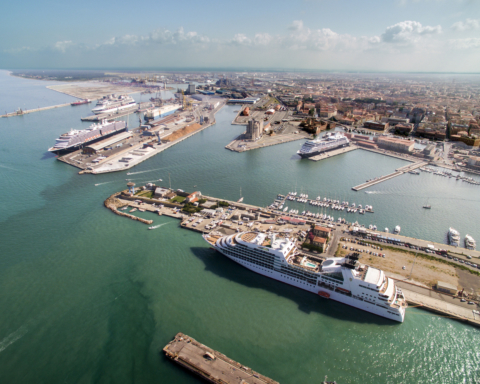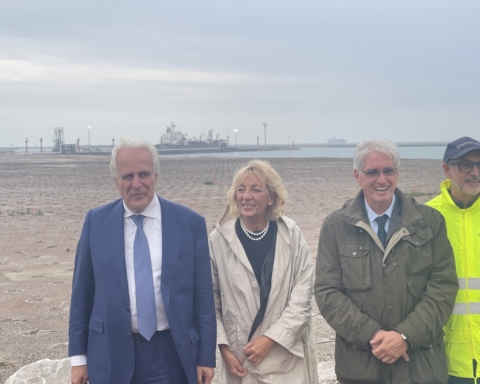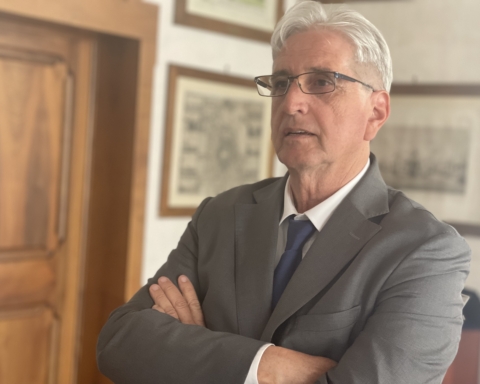550 million good reasons to believe in the future of the port of Livorno and its Darsena Europa, the seaward expansion project thanks to which the port aims to obtain new areas for fully developing its traffic such as its container and ro-ro sectors.
From Palazzo Rosciano, headquarters of the North Tyrrhenian Port Network Authority, Stefano Corsini is cautiously optimistic when it comes to the figures.
With the Unified Conference ‘s recent approval of the decree proposed by the Infrastructure and Transport Minister, Paola De Micheli, which allocates, among other things, 200 million euros to the construction of Livorno port’s new container terminal, the Darsena Europa project has now secured 550 million euros in public funding .
“This is an extraordinary result” – commented the president of the North Tyrrhenian Port Network Authority – “which both the Government and Tuscany Regional Administration have certainly contributed to achieving”, in particular the Ministry for Infrastructure & Transport “which, from 2017 to this day, has never failed to include the first phase of Darsena Europa project in its infrastructure annex to the DEF.” (Economic & Financial planning Document- Translator’s Note)
After the 200 million euros granted by Tuscany Regional Administration, the 50 million euros allocated by CIPE ( Interministerial Committee for Economic Planning – Translator’s Note) in 2016 and the 100 million euros from Port Network Authority funding, “the new funds made available by the State allow us to approach the leading players with encouraging expectations about the success of the operation.”
An operation that – Mr Corsini reiterates – will allow Livorno to avoid the devastating effects of naval gigantism, which has reduced many port terminals to becoming progressively obsolete, making it impossible for a number of international ports to compete at global level
“Darsena Europa was set up for one reason only: to move the container traffic from Darsena Toscana to the new infrastructure. The objective that we would achieve will be twofold: on the one hand, we will free up areas in the current commercial port for other types of traffic, on the other hand, we will be able to develop the full potential of the container port, offering operators facilities and draughts to suit their needs.”
When fully operational, the Darsena Europa should handle 1.6 million TEUs, about 50% more than the port currently handles. “We are convinced that the operation is financially sustainable,” says Mr Corsini, who never tires of emphasizing how the work is deeply rooted in the national and sector planning and how at Palazzo Rosciano not a day goes by without the process of moving towards the implementation of the project being enriched with new important steps.
“We have already sent the documentation to the Ministry of Environment for starting the EIA procedure and within a few days we will send the final “cold” (i.e non cashflow generating infrastructure- Translator’s Note) works project (breakwaters and dredging)to the Consiglio Superiore dei Lavori Pubblici (Supreme Council responsible for overseeing public works- Translator’s Note). Meanwhile we are preparing the documents for the revised container terminal feasibility study, in order to draw up the project financing tender”.
The message is clear: if, in the meantime, no private party should come forward with its own project to be put to tender, the Port Network Authority will go ahead with the public-private partnership: ” After subtracting about 300 million euros needed for the maritime infrastructure, another 250 million euros will be available to be allocated to the Terminal Project Financing”. It may well be that the 200 million euros recently allocated by the Ministry for Infrastructure & Transport, even in the Covid period, could be the springboard for encouraging interested parties to put their cards on the table “.
For the time being, whilst waiting for private investors, the only people who have come forward are representatives from environmental associations in Pisa, who, over the last few days, have been asking for more reassurance on the infrastructure’s environmental impact and greater involvement in the decision-making . Mr. Corsini calmly replies: “The defense works and dredging will be subject to the EIA procedure pertaining to the State. This is a key moment that that calls for the participation, among others, of members of the public and interested groups”.
Going into detail on the issue, the leading figure of the ports of Livorno and Piombino points out that the new breakwaters will have a limited environmental impact on the morphology of the coastline up to 3 km from the mouth of the overflow canal. “We do not intend to underestimate the fears of Legambiente (the Italian environmentalist association- Translator’s Note) or those who, in the past, expressed concerns about coastal erosion, or the alteration of the underwater environment. However, we know that in the project foresees the appropriate environmental mitigation works and that the seabed depths will be regularly maintained.
In addition, “it is expected that the 5.3 million cubic meters of sandy material with suitable characteristics in terms of grain size and quality resulting from dredging activities will be used to restore the morphology of the coastline south of Marina di Pisa”.
In the meantime, the Port Network Authority is preparing to receive authorization from the Ministry of the Environment for the deperimetration of the Site of Natonal Interest areas in front of the future Darsena Europa. For the port of Livorno and Piombino’s leading figure this is a fundamental and essential step: “The conclusion of the deperimetration process will allow us to proceed with the specific environmental characterization necessary for the authorization to carry out dredging activities.”
Translation by Giles Foster




